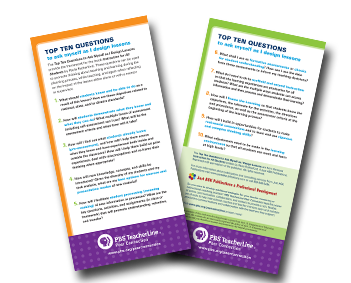
Volume VI Issue IX
Share this newsletter on
Ladies and Gentlemen, Start Your Engines

Bruce facilitating a Leading the Learning® workshop
The title of Volume IV Issue VI of Just for the ASKing! was Stop…In the Name of Learning. The focus of that issue was on practices that inhibited or hindered student learning. This issue sheds light on teacher behaviors that promote and increase students’ ability to learn. I’ve had the pleasure of visiting many classrooms throughout my career. What makes some visits especially exciting is to see true learning taking place as evidenced by the words and actions of the students themselves. During some recent visits, I began jotting down specific decisions that teachers made that expedited the learning process and made for successful classroom experiences. I also had the chance to talk with many of the teachers to ask them about their teaching decisions. What I learned was both interesting and inspiring; I concluded that their insights were well worth sharing with other educators. Three basic patterns emerged from my conversations:
- Successful teaching is an evolving process.
- It is important to keep an open mind because new and promising ideas are constantly emerging.
- When a strategy or method clearly increases student learning, it is essential to follow the practice as early as possible in the school year so that the students become accustomed to a specific way of thinking and acting.
I describe below specific practices gleaned from classroom observations and conversations with these successful teachers.
- Practice routines and procedures from the very beginning of the year.
Be sure that students know precisely how business will be conducted in the classroom. Some teachers simply talk about their expectations or distribute copies of “dos and don’ts” to their students. Teachers who have their students model and/or rehearse the procedures have found that their students take the practices more seriously and remember them for a much longer period of time.
- Get to know as much as possible about each student.
In my observations of accomplished teachers, I noticed again and again that when they interacted with their students, they frequently made reference to specific information about individual children. It was more than apparent that they really knew a great deal about their learners. When I inquired about what I had observed, I learned that many of the teachers moved beyond simply having their students fill out an opening day information sheet. Instead they spent some time during the first week of school administering various inventories (e.g., learning styles, multiple intelligences, etc.) in order to learn about “how their students learned.” They used this accumulated data throughout the year to provide differentiated instruction, group students for learning activities, or to assess student learning using varied approaches.
- “Think of yourself as a teacher and learner and not as a warden or guard.”
The teacher who provided this profound statement elaborated by saying that his constant and on-going endeavor was to consistently plan exciting student-centered lessons with clear standard-based outcomes. He often asked his students to explain their understanding about why they were doing what they were doing and how it contributed to their increased learning. As a relatively young teacher, he learned quickly that planning was the key to success and it made his job much more satisfying to focus on learning and not on nagging and correcting student behavior.
- Look at things from the students’ perspective.
One teacher told me she began her year’s planning by literally sitting in a student’s desk and facing the front of the room. She stumbled upon this seemingly simple gesture by accident but she said that it stuck with her and served as a reminder of what it’s like to be a student in her class. She explained that she often had a mental picture of herself sitting in that desk and it guided her decision making again and again throughout the school year.
- Bring creativity, imagination, and surprise to your lessons.
Some teachers become so entrenched in following their curriculum mandates or pacing guides that they limit their teaching repertoire to drill and practice or fact-based learning. The teachers with whom I spoke took great pride in planning interesting lessons that were memorable, student-centered, and often included student movement. They found that students consistently mastered the content because their curiosity had been piqued, their interest had been captured, and their learning was a natural outgrowth of an active learning experience.
- Adequately prepare students for the work they are to complete.
One especially strong pattern that emerged in my interactions with teachers was their purposeful decision to set their students up for success by scaffolding learning. They made a conscious decision to fill in learning gaps, dispel misconceptions, and provide background information before asking students to tackle a reading assignment, view a video, or complete individual or group work. As a result of this proactive thinking on the teachers’ parts, student frustration was almost non-existent because the necessary groundwork had been laid beforehand.
- Establish a learner-centered classroom.
The classes I visited were busy, the students were animated, and most importantly, the learning outcomes were clear. In the vast majority of cases, whenever I asked students why they were doing what they were doing, they could explain how their current experience was connected to a specific objective. Rarely did these students tell me that they were getting ready for the test. What was especially uplifting was how many students could connect their learning to their lives beyond the classroom.
- Pause on a regular basis to let students process their learning.
The research is clear that even the most successful and focused learners cannot sustain their attention for an indefinite period without losing their concentration or letting their minds wander. Typically, strong teachers stop and allow their students to confer with a neighbor, process in a small group, or jot down their thoughts about the current content. These student discussions/reactions/summarizers should not be neglected because they are powerful tools in the learning process.
- Emphasize literacy.
No matter what subject one teaches, students should have the opportunity to frequently read and write about the content under study. It is important to remember that students will be reading and writing throughout their adult lives and most of what they will read will be non-fiction. Again and again, I see adults in a wide range of jobs in the world of work who rely on their ability to read and comprehend in order to complete their jobs in a competent manner. Wise teachers also carefully plan how they will address the topic of literacy making sure to avoid lengthy packets, extensive coloring, or unchallenging busy work.
- Assign homework and home projects with care and deliberation.
In my teacher interviews, I discovered a consistent pattern in their thinking related to homework that could best be summarized in the following statements: Asking students to complete homework without adequate teaching and preparation is an exercise in futility for students and a source of frustration for teachers when it is not completed. These teachers further explained that they do not assign complicated home projects because they realize that not all students have access to materials and resources. As one teacher put it, “It is unrealistic and counterproductive to ask students from low socioeconomic settings to produce work which is next to impossible to complete.”
- Identify the cause of incomplete or non-existent student work and plan an intervention aligned with the cause.
It should come as no surprise to today’s educators that some students are inconsistent in following through on homework or other assignments. As teachers mull over their response to this inconsistency, an important question to ask is: Is it skill or will that is keeping students from doing required work? Putting it another way, ask yourself whether students who do not complete their work are doing so to be willfully disobedient or are they incapable of doing the work because they lack the background knowledge, necessary skills, or resources?
- Seek answers and solutions to problems rather than practice “blamestorming.”
It is relatively easy to sit back and point fingers when things don’t go well. Blaming “those kids,” “these parents,” or “that administration” is like running in place; there is little or no progress. Highly motivated teachers with optimistic outlooks simply do not engage in “blamestorming,” the antithesis of brainstorming. Research findings have concluded that many answers to problems that teachers encounter are right across the hall or right next door. Educators who engage in on-going collaborative practices with student learning as the consistent emphasis often discover that their conversations result in new approaches, creative answers, and productive practices that offer solutions and eliminate excuses.
- Stay the course.
Several of the teachers I observed and spoke with were in their first year of teaching. They explained that they did not enter the profession with a sense of idealism; they realized that there would be frustrations and complications. One teacher said, “I knew from the get-go that I would stick it out despite the obstacles that I might face.” A second teacher realized that “I would encounter children who would be less than cooperative and who would struggle with their learning.” Believing in and not giving up on children, especially in troublesome and complicated situations, is one of the most important components of teachers’ responsibilities.
However and whenever you start your engines, keep your eye on your final destination: educating our children. When you make wise decisions in the interest of student learning, you will be sure to see that checkered flag as you cross the finish line at the conclusion of a successful school year.
Permission is granted for reprinting and distribution of this newsletter for non-commercial use only. Please include the following citation on all copies:
Oliver, Bruce. “Ladies and Gentlemen, Start Your Engines.” Just for the ASKing! September 2009. Reproduced with permission of Just ASK Publications & Professional Development (Just ASK). © 2014 by Just ASK. All rights reserved. Available at www.justaskpublications.com.
Free Top Ten Tips to Ask Myself as I Design Lessons
“These questions can be used to promote thinking about teaching and learning during the planning process, while teaching, and again when reflecting on the impact of the lesson either alone or with a mentor or supervisor.”





